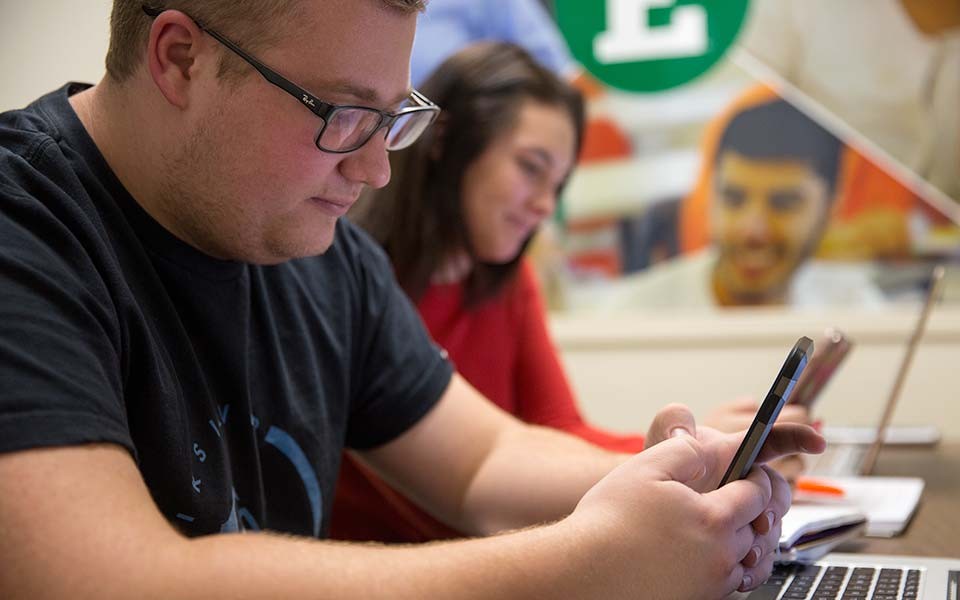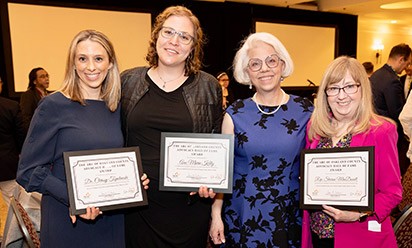Rethinking the smartphone's place in the classroom

Smartphones have revolutionized the way we communicate. They’ve also become a new source for distraction. Think crossing streets, driving, at the movies…and in class.
While many professors ask students to turn their phones off or simply not bring them to class, EMU Associate Professor of Engineering Technology Muhammad Ahmed is developing an innovative way of engaging students through smartphone technology.
For the past four years, Ahmed has worked on a smartphone app—provisionally called “iRes” (short for I Response)—that enables students to answer classroom questions through a texting service. The app would replace the “clicker,” a device similar to those studio audiences use on TV programs like “America’s Funniest Home Videos.” Students currently use clickers in class to submit answers to multiple choice questions or surveys.

“Students can text faster than I can type,” Ahmed says. “I wondered how we can use this skillset the students have developed? I want to turn smartphones into classroom discussion facilitators.”
A single clicker costs about $40. That’s not overly expensive, but costs can escalate if students forget to return them to the instructor. Clickers also break easily when dropped.
In contrast, iRes will run on students’ personal smartphones as a free web-based application. Future versions will be available as a downloadable app for the Android and iPhone.
But iRes isn’t just about saving money and eliminating hardware. The app also fosters classroom discussion by enabling students to answer questions in sentences and short paragraphs—much like text messages.
“The app creates an environment of effective communication and facilitates collaborative learning,” Ahmed says. “In a typical classroom of about 20 students, only the most vocal students will respond to questions. iRes will allow all students to participate equally.”
iRes will also record student responses and send that data to the instructor in real time.
“The software analyzes student responses, summarizes their reasoning, and breaks them down by highlighting major arguments for and against a point,” Ahmed says. “Instructors won’t have to spend hours reading individual responses to evaluate how students are performing. At the same time, the system can highlight individual student responses for separate reading. This technology isn’t available in any other product in the marketplace.”
In the spring of 2016, Ahmed further honed his work by participating in a National Science Foundation Innovation Corps (I-Corps) workshop held at Wayne State University. This ongoing program focuses on the commercialization of scientific research conducted nationwide.
“I-Corps helped us further define our customers and develop the skill set to refine our basic research into something that could be commercially viable,” Ahmed says.
Ahmed is seeking funding to further develop new software to accompany the completed app architecture. He hopes to perform beta testing next summer and launch a detailed study within EMU College of Technology and College of Arts & Sciences classes during the Fall 2018 and Winter 2019 semesters.
“In my 20 years of teaching, I’ve learned there is no one methodology that works best,” Ahmed says. “It’s up to faculty to engage students and find new ways of connecting with them. iRes can be a great tool to involve students in active learning.”
December 05, 2017
Written by:
Jeff Samoray
Media Contact:
Darcy Gifford
dgiffor2@emich.edu
734.487.5375
More Stories

Eastern Michigan University professors receive Disability Advocacy Hall of Fame Award from The Arc of Oakland County Michigan.

Eastern Michigan University alumna, Aleksandra Efimova, leads self-made brand, RP to acquisition by renowned industry leader in dance footwear and apparel, Bloch.
Eastern Michigan University Vice President for Enrollment Management Katie Condon-Martin to help shed light on FAFSA “fiasco” as part of Bridge Michigan Zoom discussion on April 24.

Eastern Michigan University awards Summer Research and Creative Activity Grants.

Eastern Michigan University to launch new Bachelor of Business Administration in Financial Planning and Wealth Management degree.

